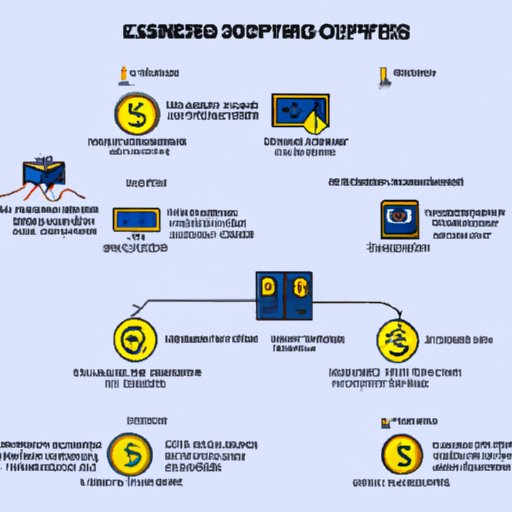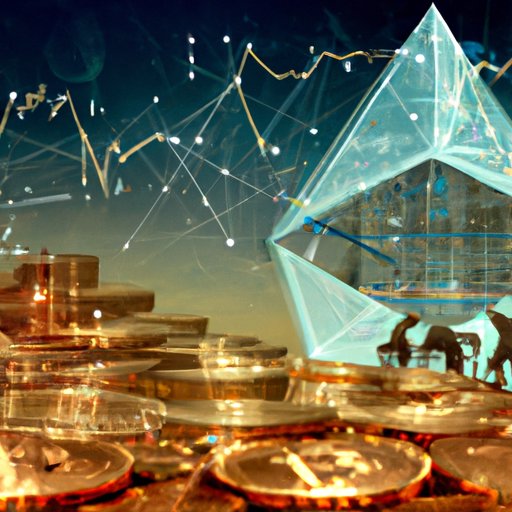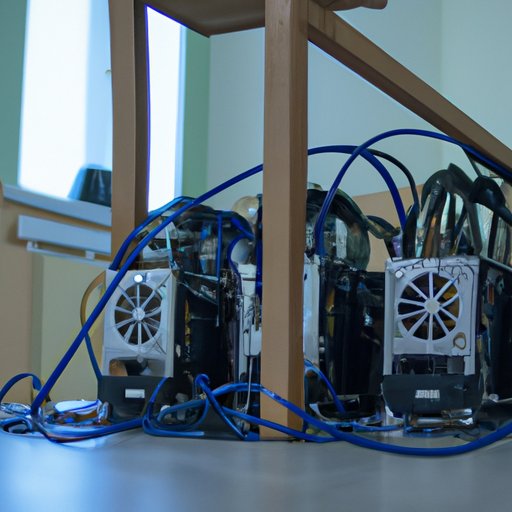Introduction
Cryptocurrency mining is the process of using specialized computers to solve complex mathematical problems in order to verify and secure digital transactions on a blockchain network. Cryptocurrency miners are rewarded with newly created coins or transaction fees for their work. In this article, we’ll explore the basics of cryptocurrency mining, the steps involved, and the tools needed. We’ll also discuss the potential rewards and risks associated with mining cryptocurrencies.
Explaining the Basics of Cryptocurrency Mining
Before diving into the specifics of how to mine cryptocurrency, it’s important to have a basic understanding of what exactly cryptocurrency mining is. Cryptocurrency mining is the process of verifying and adding transactions to a public ledger known as a blockchain. This process is done by solving complex mathematical puzzles with specialized computers. Miners are rewarded for their work with newly created coins or transaction fees.
There are two different types of cryptocurrency mining: Proof-of-Work (PoW) and Proof-of-Stake (PoS). In PoW systems, miners compete against each other to solve complex mathematical puzzles. The miner who solves the puzzle first is rewarded with newly created coins. In PoS systems, miners are rewarded with transaction fees for validating transactions.

Outlining the Steps Involved in Mining Cryptocurrency
Mining cryptocurrency involves several steps, including setting up a cryptocurrency mining rig, installing mining software, joining a mining pool, choosing a cryptocurrency to mine, and monitoring the progress of mining. Let’s take a closer look at each step.
Setting Up a Cryptocurrency Mining Rig
The first step in mining cryptocurrency is setting up a mining rig. A mining rig is a computer specifically designed for mining cryptocurrency. It consists of multiple powerful graphics cards, a motherboard, and a power supply unit. Setting up a mining rig can be time-consuming and expensive, depending on the hardware components you choose.
Installing Mining Software
Once your mining rig is set up, the next step is to install mining software. Mining software is used to connect your mining rig to a blockchain network. Different types of mining software are available, so it’s important to do your research before choosing one. Some popular mining software includes CGMiner, BFGMiner, and MultiMiner.
Joining a Mining Pool
Once you’ve installed mining software, the next step is to join a mining pool. A mining pool is a group of miners working together to mine cryptocurrency. By joining a mining pool, you can increase your chances of earning rewards for mining. Popular mining pools include SlushPool, F2Pool, AntPool, and BTC.com.
Choosing a Cryptocurrency to Mine
After joining a mining pool, the next step is to choose a cryptocurrency to mine. There are hundreds of different cryptocurrencies available, so it’s important to do your research before choosing one. Popular cryptocurrencies include Bitcoin, Ethereum, Litecoin, and Monero.
Monitoring the Progress of Mining
Finally, once you’ve chosen a cryptocurrency to mine, the last step is to monitor the progress of mining. Most mining software includes a dashboard that allows you to view the current status of your mining rig. You can use this dashboard to track the progress of mining, as well as to adjust settings such as hash rate and fan speed.
Describing the Tools Needed for Cryptocurrency Mining
Mining cryptocurrency requires both hardware and software components. Let’s take a closer look at the tools needed for mining cryptocurrency.
Hardware Components
The hardware components required for mining cryptocurrency include a mining rig, a power supply unit, and a cooling system. A mining rig is a computer specifically designed for mining cryptocurrency. It consists of multiple powerful graphics cards, a motherboard, and a power supply unit. A cooling system is also recommended to prevent your mining rig from overheating.
Software Components
In addition to hardware components, mining cryptocurrency also requires software components. These include mining software, a wallet, and a mining pool. Mining software is used to connect your mining rig to a blockchain network. A wallet is used to store your mined coins. Finally, a mining pool is a group of miners working together to mine cryptocurrency.

Discussing the Benefits and Risks of Cryptocurrency Mining
Cryptocurrency mining offers both benefits and risks. Let’s take a closer look at the advantages and disadvantages of mining cryptocurrency.
Benefits of Cryptocurrency Mining
The primary benefit of cryptocurrency mining is the potential to earn rewards for validating digital transactions. Miners are rewarded with newly created coins or transaction fees for their work. In addition, some miners may choose to hold onto their coins and take advantage of price appreciation over time. Finally, mining cryptocurrency can be a fun and rewarding hobby for tech-savvy individuals.
Risks of Cryptocurrency Mining
The primary risk associated with cryptocurrency mining is the potential financial loss due to volatile prices. Cryptocurrency prices are highly volatile and can fluctuate significantly over short periods of time. As such, miners may find themselves in a situation where they’ve invested significant amounts of money in mining equipment only to find that the value of their coins has decreased significantly.

Analyzing the Profitability of Cryptocurrency Mining
When it comes to mining cryptocurrency, the question of profitability is always top of mind. To determine the profitability of mining cryptocurrency, it’s important to calculate the costs and potential returns. Let’s take a closer look.
Calculating Profitability
To calculate the profitability of mining cryptocurrency, you must first calculate the total cost of mining. This includes the cost of mining hardware, mining software, electricity, and other related expenses. Once these costs are calculated, you must then compare them to the potential returns from mining. This includes the rewards from mining, as well as any potential price appreciation over time.
Examining the Costs of Cryptocurrency Mining
As mentioned above, the costs of mining cryptocurrency include the cost of mining hardware, mining software, electricity, and other related expenses. Mining hardware can be expensive, with high-end rigs costing thousands of dollars. Additionally, mining cryptocurrency consumes a lot of electricity, so you should factor in the cost of electricity when calculating the total cost of mining.
Evaluating the Potential Returns from Cryptocurrency Mining
The potential returns from mining cryptocurrency include the rewards from mining, as well as any potential price appreciation over time. Generally, miners are rewarded with newly created coins or transaction fees for their work. Additionally, some miners may choose to hold onto their coins and take advantage of price appreciation over time.
Conclusion
In conclusion, cryptocurrency mining is the process of verifying and adding transactions to a public ledger known as a blockchain. Mining cryptocurrency involves several steps, including setting up a mining rig, installing mining software, joining a mining pool, choosing a cryptocurrency to mine, and monitoring the progress of mining. Mining cryptocurrency requires both hardware and software components. Finally, the profitability of mining cryptocurrency depends on the costs and potential returns.
We hope this article has provided a comprehensive overview of cryptocurrency mining. For more information, check out our additional resources on cryptocurrency mining.
(Note: Is this article not meeting your expectations? Do you have knowledge or insights to share? Unlock new opportunities and expand your reach by joining our authors team. Click Registration to join us and share your expertise with our readers.)
